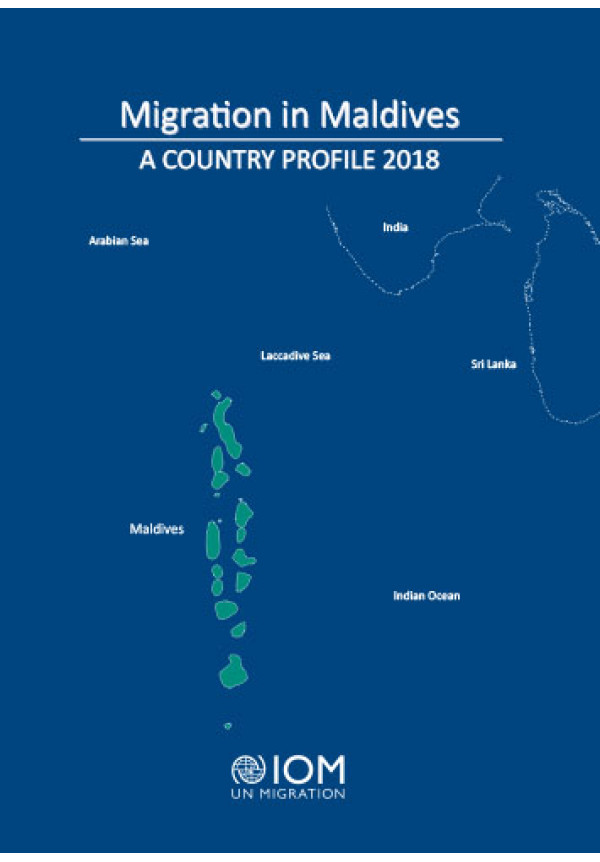
Migration in Maldives: A Country Profile 2018
This Migration Profile is the result of a two-year project (2016–2018) implemented by the International Organization for Migration at the request of and in partnership with Maldives Immigration, under the purview of the Ministry of Economic Development. It brings together all available relevant data and information on migration and provides policy directives and recommendations to enhance evidence-based policymaking and implementation. This Migration Profile is expected to spark a dynamic process that fosters long-term multi-stakeholder collaboration on migration data and governance, which should include regularly updating and disseminating information, complemented by awareness-raising and capacity-building activities that are in line with recommendations made by various actors to address identified gaps. Such collaboration, in turn, will ensure national stakeholders’ ownership of the Migration Profile process going forward and, therefore, its long-term sustainability.
This Migration Profile first examines the demographic, socioeconomic and labour market characteristics of Maldives. It then presents key figures and trends relating to international and internal migration, and then analyses links between migration and the country’s socioeconomic development. It also reviews migration governance at the national and international levels, including laws and policies that touch upon migration and migrants’ rights, and gives a rundown of the wide array of national institutions involved in migration management and data collection. Summarizing and reflecting on key findings, the Migration Profile concludes by offering targeted, practical and realistic recommendations for future policy development in relation to migration governance and data management in the Republic of Maldives that policymakers will find useful.
Read More
- Acknowledgements
- Abstract
- List of tables
- List of figures
- Abbreviations and acronyms
- Executive summary
- Part A: Country context
- A.1. Socioeconomic development
- A.2. Population dynamics
- A.3. Labour market characteristics
- A.3.1. Employment trends
- A.3.2. Unemployment
- Part B: Migration trends and characteristics
- B.1. Emigration
- B.1.1. Historical evolution
- B.1.2. Maldivian students abroad
- B.1.3. Maldivian refugees and asylum seekers abroad
- B.1.4. Non-resident Maldivians abroad
- B.1.5. Maldivian health and leisure travellers
- B.1.6. Naturalization of Maldivians abroad
- B.2. Internal migration
- B.2.1. National statistics on internal movements
- B.2.2. Internal migration and national development
- B.2.3. Internal migration and environmental threats
- B.3. Immigration
- B.3.1. Data from international and national sources
- B.3.2. Visas and airport arrivals and departures
- B.3.3. Labour migration
- B.3.4. Refugees and asylum seekers
- B.3.5. Irregular migration
- B.1. Emigration
- Part C: Impacts of migration on development
- C. 1. Migration and economic development
- C.1.1. Remittances
- C.1.2. Return migration and diaspora engagementi
- C.2. Migration, employment and the labour market
- C.2.1. Tourism
- C.2.2. Health
- C.2.3. Education
- C.2.4. Construction
- C.3. Migration and social development
- C.3.1. Migration and health
- C.3.2. Migrants’ working and living conditions
- C. 1. Migration and economic development
- Part D: Migration governance
- D.1. International context
- D.1.1. International treaty obligations
- D.1.2. International cooperation
- D.2. National legal and policy frameworks
- D.2.1. Admission of migrant workers
- D.2.2. Trafficking and smuggling
- D.2.3. Migrants’ access to health care
- D.2.4. National Development Plan
- D.2.5. Pension and other social security benefits
- D.3. Institutional and data frameworks
- D.3.1. Ministry of Economic Development
- D.3.2. Maldives Immigration
- D.3.3. National Centre for Information Technology
- D.3.4. National Bureau of Statistics
- D.3.5. Ministry of Health
- D.3.6. Health Protection Agency
- D.3.7. Ministry of Tourism
- D.3.8. Ministry of Education
- D.3.9. Labour Relations Authority
- D.3.10. Ministry of Foreign Affairs
- D.3.11. Diplomatic missions in Maldives
- D.3.12. Local government
- D.3.13. Maldives Police Service
- D.3.14. Employment Tribunal
- D.3.15. International organizations
- D.3.16. Civil society
- D.1. International context
- Part E: Conclusion
- E.1. Key findings
- E.1.1. Country context
- E.1.2. Migration trends and characteristics
- E.1.3. Impacts of migration on development
- E.1.4. Migration and social development
- E.1.5. Migration governance
- E.2. Key recommendations
- E.2.1. Data management
- E.2.2. Migration governance
- E.1. Key findings
- Annexes
- Annex I: Practical guidelines to verify progress towards fair recruitment and working conditions
- Annex II: Challenges in migration-related data collection and management in Maldives
- Annex III: Key labour market characteristics of Maldives
- Bibliography